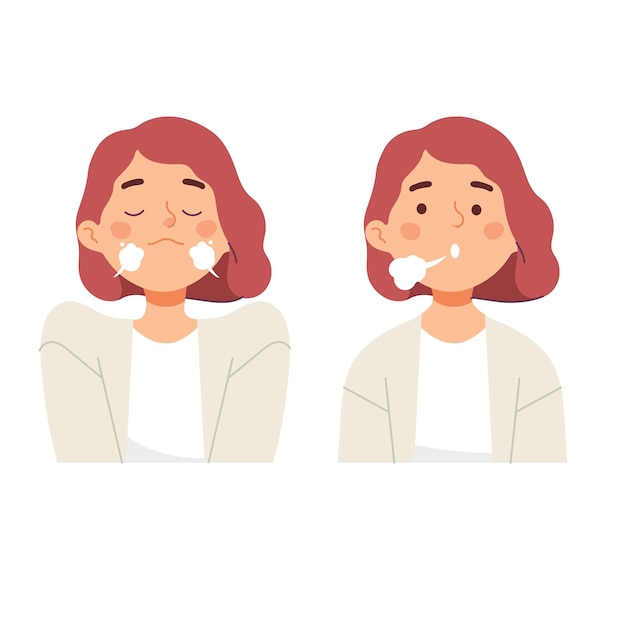
Bad breath, or halitosis, is something nearly everyone deals with at some point. It can be triggered by various factors like a dry mouth, protein-heavy diets, sugary or acidic foods, smoking, illnesses, or tooth decay. Luckily, bad breath can often be prevented with good oral hygiene, lifestyle changes, and a healthy diet. Here’s a breakdown of some easy and effective ways to tackle halitosis.
### Maintaining Good Oral Hygiene
#### 1. Proper Brushing Techniques
Brushing your teeth the right way is key to keeping bad breath in check. Make sure to brush at least twice a day for about two minutes each time, covering all areas of your mouth. Focus especially on where your gums and teeth meet for a thorough clean.
#### 2. Choosing the Right Toothbrush
Use a soft-bristled toothbrush and replace it every three to four months. If brushing before or after eating, wait at least an hour to protect your enamel. Don’t forget to clean your tongue, as it can harbor bacteria that contribute to bad breath. Brush the back and sides of your tongue gently, but don’t overdo it—three to four strokes are enough.
#### 3. Don’t Skip Flossing
Flossing is just as important as brushing because it removes plaque and food particles from between teeth, areas that brushes can’t always reach. Make sure to floss daily, focusing on the spaces where teeth and gums meet.
#### 4. Add Baking Soda to Your Routine
Once a week, use a little baking soda to brush your teeth. It helps neutralize acids and can reduce bacteria in hard-to-reach areas.
#### 5. Visit Your Dentist Regularly
Seeing a dentist regularly ensures your teeth and gums are professionally cleaned and checked for any underlying issues that could contribute to bad breath. Dentists can also help diagnose and treat any conditions causing persistent halitosis.
#### 6. Opt for Sugar-Free Products
Choose sugar-free mints or gum to stimulate saliva flow in your mouth, which washes away bacteria and freshens your breath. The sweetener in these products also helps protect against tooth decay.
#### 7. Use Mouthwash Wisely
Mouthwash can temporarily freshen your breath by killing odor-causing bacteria. Look for types with ingredients like chlorine dioxide, cetylpyridinium chloride, or zinc chloride, but avoid alcohol-based ones, which can dry out your mouth. For best results, rinse and gargle thoroughly.
### Lifestyle and Diet Adjustments
#### 1. Stay Hydrated
Dry mouth is a major cause of bad breath. Drink plenty of water to rinse away bacteria and food particles. Avoid drinks like coffee, soda, and alcohol, which can dry out your mouth.
#### 2. Eat Fiber-Rich Foods
Crunchy vegetables and fruits, like apples and celery, help clean your teeth naturally while aiding digestion. They can also reduce toxins in your body that might contribute to bad breath.
#### 3. Cut Down on Sugary Treats
Sugary foods and drinks feed bacteria in your mouth, which can lead to bad breath and harm your teeth. Swap out sugary treats for healthier options whenever possible.
#### 4. Quit Smoking and Chewing Tobacco
Smoking and tobacco products leave a stale odor in your mouth. Giving up tobacco not only improves your breath but also promotes healthier teeth and gums.
#### 5. Include More Vitamin D in Your Diet
Vitamin D helps regulate bacteria in your mouth. You can get it from sunlight, supplements, or foods like fatty fish (tuna or salmon), mushrooms, or fortified dairy products. Sugar-free yogurt, which contains probiotics, is especially helpful in reducing odor-causing compounds.
#### 6. Use Herbs and Spices
Chew on parsley, mint, or fennel seeds for a natural breath freshener. You can also try steeping mint leaves in hot water to make a refreshing tea. Lemon wedges sprinkled with salt can help neutralize strong odors from foods like garlic or onions.
#### 7. Drink Green or Black Tea
Both green and black teas are rich in polyphenols, which fight bacteria and reduce sulfur compounds that cause bad breath. Unsweetened tea is best, as it provides hydration while keeping your mouth fresh.
### Recognizing and Managing Bad Breath
#### 1. Self-Check for Bad Breath
You can test your breath by exhaling into your cupped hands or using a basic breath analysis tool. Sometimes a bad taste in your mouth can also indicate bad breath.
#### 2. Consider Advanced Diagnosis Tools
Devices like a halimeter can measure specific chemicals in your breath, like hydrogen sulfide or methyl mercaptan, to identify the source of halitosis.
#### 3. Try Home Remedies
Incorporate simple oral care practices like brushing and flossing twice a day and using fluoride toothpaste. A good toothbrush and quality toothpaste can effectively eliminate odor-causing food and plaque buildup.
#### 4. Stimulate Saliva Production
Chewing sugar-free gum or sucking on sugar-free mints can help keep your mouth moist. Eating fibrous fruits and vegetables also encourages saliva flow, which washes away food particles.
#### 5. Avoid Chemical-Rich Products
Products containing ingredients like sodium lauryl sulfate or alcohol can cause dryness in the mouth, worsening bad breath. Instead, choose those designed for sensitive mouths to maintain proper oral health.
### In Summary
Chronic bad breath, which affects over 80 million people, is a common issue. By following these simple steps—maintaining good oral hygiene, making smarter dietary choices, and staying hydrated—you can keep halitosis at bay and enjoy fresh, healthy breath.